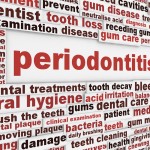
Periodontitis results in damage to the bone and connective tissues supporting the teeth. The use of barrier membranes aims to assist regeneration of periodontal tissues in order to overcome some of the limitations of conventional treatment. The aim of this review was to assess the outcomes of guided tissue regeneration (GTR) using an absorbable collagen membranes (CM), alone or in association with bone substitutes, as compared with those achieved with standard open flap debridement (OFD).
Searches of the Cochrane Central Register of Controlled Trials, Medline, and Embase databases and journals (Journal of Periodontology, Journal of Clinical Periodontology, and Journal of Periodontal Research) were undertaken. Randomized or quasi-randomized controlled trials (RCTs) that compared GTR with bioabsorbable CM, with or without the application of bone substitutes and other bio-active materials, with OFD alone were included. Studies addressing only furcation defects were excluded. Two reviewers conducted study selection and data abstractions independently. Primary outcomes were tooth loss and gain in clinical attachment level (CAL).
- 21 studies were included reporting 17 trials involving 507 patients. The risk of bias in the included studies was generally high.
- No data were available for the primary outcome tooth loss.
- The summary treatment effect for change in CAL for GTR with CM compared with OFD was 1.58 mm (95% CI, 1.27 to 1.88), heterogeneity (I2 = 75%, p < .001).
- 16 reported on changes in probing pocket depths (PPD). The analysis suggested that GTR with bioabsorbable CM had a greater mean reduction in PPD than did OFD, with a weighted mean difference (WMD) of 1.52 mm (95% CI, 1.18 to 1.86).
- No differences in treatment effects were detected between trials of GTR with CM alone and trials of GTR with CM in combination with bone substitutes (p for interaction, 0.31).
The authors concluded
…..GTR with CM, with or without bone substitutes, may lead to improved clinical outcomes compared with those achieved with OFD alone. Our meta-analysis lends support to this concept in the treatment of infrabony periodontal defects.
Comment
The authors note that the included trials were generally of poor methodological quality and only involved a restively small number of patients. This together with the high degree of heterogeneity in the included studies would suggest caution in the interpretation of the results. The Cochrane review by Needleman et al 2008 considered a wider range of GTR materials. They included 17 trials and found for CAL the mean difference between GTR and OFD was 1.22 mm (95% CI Random Effects: 0.80 to 1.64). Needleman et al concluded:-
GTR has a greater effect on probing measures of periodontal treatment than open flap debridement, including improved attachment gain, reduced pocket depth, less increase in gingival recession and more gain in hard tissue probing at re-entry surgery. However there is marked variability between studies and the clinical relevance of these changes is unknown. As a result, it is difficult to draw general conclusions about the clinical benefit of GTR. Whilst there is evidence that GTR can demonstrate a significant improvement over conventional open flap surgery, the factors affecting outcomes are unclear from the literature and these might include study conduct issues such as bias. Therefore, patients and health professionals need to consider the predictability of the technique compared with other methods of treatment before making final decisions on use. Since trial reports were often incomplete, we recommend that future trials should follow the CONSORT statement both in their conduct and reporting.
There is therefore little value in future research repeating simple, small efficacy studies. The priority should be to identify factors associated with improved outcomes as well as investigating outcomes relevant to patients. Types of research might include large observational studies to generate hypotheses for testing in clinical trials, qualitative studies on patient-centred outcomes and trials exploring innovative analytic methods such as multilevel modelling. Open flap surgery should remain the control comparison in these studies.
Links
Stoecklin-Wasmer C, Rutjes AW, da Costa BR, Salvi GE, Jüni P, Sculean A. Absorbable Collagen Membranes for Periodontal Regeneration: A Systematic Review. J Dent Res. 2013 Jul 10. [Epub ahead of print] PubMed PMID: 23842107.
Needleman I, Worthington HV, Giedrys-Leeper E, Tucker R. Guided tissue regeneration for periodontal infra-bony defects. Cochrane Database of Systematic Reviews 2006, Issue 2. Art. No.: CD001724. DOI: 10.1002/14651858.CD001724.pub2.
